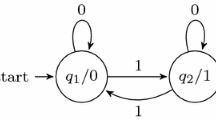Abstract
We discuss Pulsed Para-Neural Networks (PPNN) defined as graphs consisting of processing nodes and directed edges, called axons, where axons are pure delays, whereas nodes are paraneurons processing spiketrains of constant amplitude. Pusles are received and produced in discrete moments of time. We consider PPNNs with two kinds of paraneurons: MEXOR-based paraneurons (producing a pulse at clock t if it received one and only one pulse at clock t-1) and counter-based paraneuron. We present a “brain” for a mobile robot as an example of practical PPNN.
Preview
Unable to display preview. Download preview PDF.
Similar content being viewed by others
References
Buller, A.: Pulsed Para-Neural Networks (PPNN): Basic Concepts and Definitions, Technical Report TR-HIS-0007, Advanced Telecommunications Research Institute International (ATR). Human Information Science Labs (2002)
Buller, A.: CAM-Brain Machines and Pulsed Para-Neural Networks (PPNN): Toward a Hardware for Future Robotic On-Board Brains. In: 8th International Symposium. on Artificial Life and Robotics (AROB 8th 2003), Beppu, Japan, January 24-26, pp. 490–493 (2003)
Buller, A., Hemmi, H., Joachimczak, M., Liu, J., Shimohara, K., Stefanski, A.: ATR Artificial Brain Project: Key Assumptions and Current State. In: 9th International Symposium on Artificial Life and Robotics (AROB 9th), Japan, January 28-30, pp. 166–169 (2004)
Buller, A., Tuli, T.S.: Four-Legged Robot.s Behavior Controlled by Pulsed Para-Neural Networks. In: Proceedings, 9th International Conference on Neural Information Processing (ICONIP 2002), vol. 1, pp. 239–242 (2002)
Buller, A., Eeckhaut, H., Joachimczak, M.: Pulsed Para-Neural Network (PPNN) synthesis in a 3-D Cellular Automata Space, Proceedings. In: 9th International Conference on Neural Information Processing (ICONIP 2002), Singapore, vol. 1, pp. 581–584 (2002)
Buller, A., Joachimczak, M., Liu, J., Stefanski, A.: Neuromazes: 3-Dimensional Spiketrain Processors. WSEAS Transactions on Computers 3, 157–161 (2004)
Buller, A., Ahson, S.I., Azim, M.: Pulsed Para-neural Networks (PPNN) Based on MEXOR Logic. In: Pal, N.R., Kasabov, N., Mudi, R.K., Pal, S., Parui, S.K. (eds.) ICONIP 2004. LNCS, vol. 3316, pp. 399–408. Springer, Heidelberg (2004)
Eeckhaut, H., Van Campenhout, J.: Handcrafting Pulsed Neural Networks for the CAM Brain Machine. In: 8th International Symposium on Artificial Life and Robotics (AROB 8th 2003), Beppu, Japan, vol. 24-26, pp. 494–498 (2003)
Gers, F., de Garis, H., Korkin, M.: CoDi-1Bit: A Simplified Cellular Automata based Neuron Model. In: Evolution Artificiele 1997, Nimes, France, pp. 211–229 (1997)
Hecht Nielsen, R.: Neurocomputing. Addison-Wesley, Reading (1990)
Korkin, M., Fehr, G., Jeffrey, G.: Evolving Hardware on a Large Scale Proceedings. In: The Second NASA / DoD Workshop on Evolvable Hardware, Pasadena, pp. 173–81 (2000)
McCulloch, W.S., Pitts, W.: A Logical Calculus of the Ideas Immanent in Nervous Activity. Bulletin of Math. Bio. 5, 115–133 (1943)
Liu, J.: NeuroMazeTM: User.s Guide, Version 3.0. ATR Human Information Science Labs., Kyoto, Japan (2002)
Liu, J., Buller, A.: Evolving Spike-train Processors. In: Proceedings of Genetic and Evolutionary Comput., Part I, Seattle, WA, pp. 408–409. Springer, Heidelberg (2004)
Sasao, T.: Switching Theory for Logic Synthesis. Kluwer Academic Publ., Boston (1999)
Author information
Authors and Affiliations
Editor information
Editors and Affiliations
Rights and permissions
Copyright information
© 2005 Springer-Verlag Berlin Heidelberg
About this paper
Cite this paper
Li, J., Yin, Y. (2005). Pulsed Para-neural Networks (PPNN) Based on MEXORs and Counters. In: Wang, J., Liao, X., Yi, Z. (eds) Advances in Neural Networks – ISNN 2005. ISNN 2005. Lecture Notes in Computer Science, vol 3496. Springer, Berlin, Heidelberg. https://doi.org/10.1007/11427391_81
Download citation
DOI: https://doi.org/10.1007/11427391_81
Publisher Name: Springer, Berlin, Heidelberg
Print ISBN: 978-3-540-25912-1
Online ISBN: 978-3-540-32065-4
eBook Packages: Computer ScienceComputer Science (R0)




